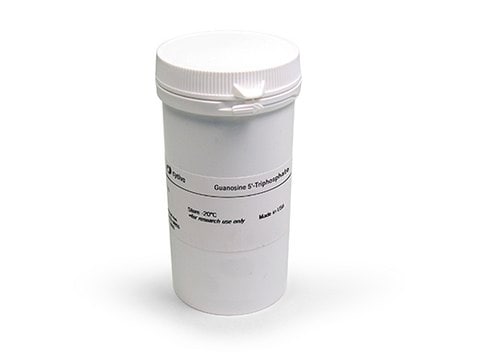10999644001
Roche
SP6/T7 Transcription Kit
sufficient for 2 x 20 assays (stadard transcription), kit of 1 (12 components), suitable for DNA sequencing, suitable for hybridization
Synonym(e):
rna labeling, radioactive, transcription kit sp6/t7
About This Item
Empfohlene Produkte
Verwendung
sufficient for 2 x 20 assays (stadard transcription)
Qualitätsniveau
Verpackung
kit of 1 (12 components)
Hersteller/Markenname
Roche
Methode(n)
DNA sequencing: suitable
hybridization: suitable
Lagertemp.
−20°C
Allgemeine Beschreibung
DNA inserted into the transcription vectors pSPT18 or pSPT19.The template DNA must be linearized with a suitable restriction enzyme before the transcription reaction to obtain transcripts of a defined length. Using intact plasmid DNA as template for transcription will result in heterogeneous transcripts of multiple plasmid lengths.
Spezifität
Anwendung
For in vitro transcription of DNA sequences cloned downstream of the SP6 or T7 promoter. Homogeneously labeled RNA can be synthesized with high efficiency (60 - 70% incorporation) using either radioactively (e.g.,32P, 3H, 35S) labeled or nonradioactively (e.g., digoxigenin or biotin) labeled ribonucleotides. Labeled transcripts lend themselves to all DNA and RNA hybridization techniques and are also used for genomic sequencing and S1 nuclease studies. Large amounts of highly pure RNA can be synthesized using the SP6/T7 system. These transcripts are used for studies on RNA-processing systems. Synthesized RNA can be translated in vitro, or in vivo after injection into oocytes. The transcription of defined mRNA can be inhibited by the introduction of "antisense"-RNA. The efficiency of in vivo translation of synthesized mRNA can be increased significantly by the introduction of a cap structure.
Verpackung
Prinzip
Angaben zur Herstellung
ATP, GTP, UTP mixture
Prepare the ATP, GTP, UTP mixture by making a 1:1:1 mixture of solution 4, solution 6, and solution 7.
Transcription Assay with digoxigenin-11-UTP
ATP, GTP, CTP mixture 1
Mix 1:1:1 of ATP (vial 4), CTP (vial 5), and GTP (vial 6).
UTP/DIG-11-UTP mixture
Mix 1:1 digoxigenin-11-UTP (6 mM) with UTP (vial 7) and add as one part to mixture 1.
"Cold" Transcription
ATP, GTP, CTP, UTP mixture
Prepare this mix by combining solutions in vials 4, 5, 6 and 7 at a ratio of 1111.
Sonstige Hinweise
Nur Kit-Komponenten
- pSPT18 DNA 0.25 mg/ml
- pSPT19 DNA 0.25 mg/ml
- Control DNA, (pSPT18- and pSPT19-neo-DNA, cleaved with Eco RI) 0.5 mg/ml
- ATP, in Tris buffer 10 mM
- CTP, in Tris buffer 10 mM
- GTP, in Tris buffer 10 mM
- UTP, in Tris buffer 10 mM
- Transcription Buffer 10x concentrated
- DNase I, RNase free, in buffer with 50% glycerol
- RNase Inhibitor, in buffer with 50% glycerol
- SP6 RNA Polymerase, in buffer with 50% glycerol
- T7 RNA Polymerase, in buffer with 50% glycerol
Signalwort
Warning
H-Sätze
Gefahreneinstufungen
Eye Irrit. 2 - Skin Sens. 1
Lagerklassenschlüssel
12 - Non Combustible Liquids
WGK
WGK 2
Flammpunkt (°F)
does not flash
Flammpunkt (°C)
does not flash
Analysenzertifikate (COA)
Suchen Sie nach Analysenzertifikate (COA), indem Sie die Lot-/Chargennummer des Produkts eingeben. Lot- und Chargennummern sind auf dem Produktetikett hinter den Wörtern ‘Lot’ oder ‘Batch’ (Lot oder Charge) zu finden.
Besitzen Sie dieses Produkt bereits?
In der Dokumentenbibliothek finden Sie die Dokumentation zu den Produkten, die Sie kürzlich erworben haben.
Kunden haben sich ebenfalls angesehen
Unser Team von Wissenschaftlern verfügt über Erfahrung in allen Forschungsbereichen einschließlich Life Science, Materialwissenschaften, chemischer Synthese, Chromatographie, Analytik und vielen mehr..
Setzen Sie sich mit dem technischen Dienst in Verbindung.






